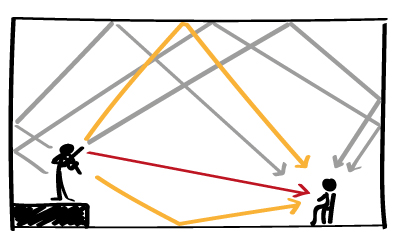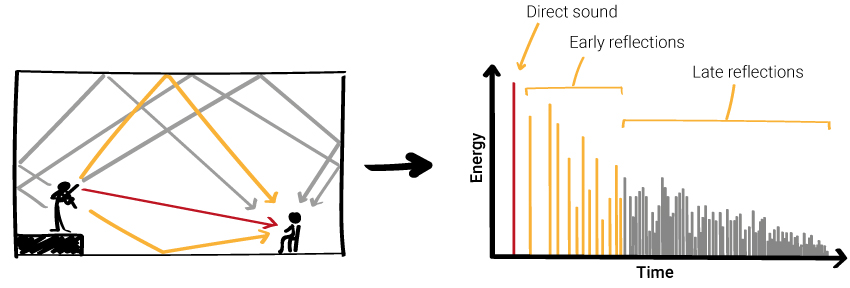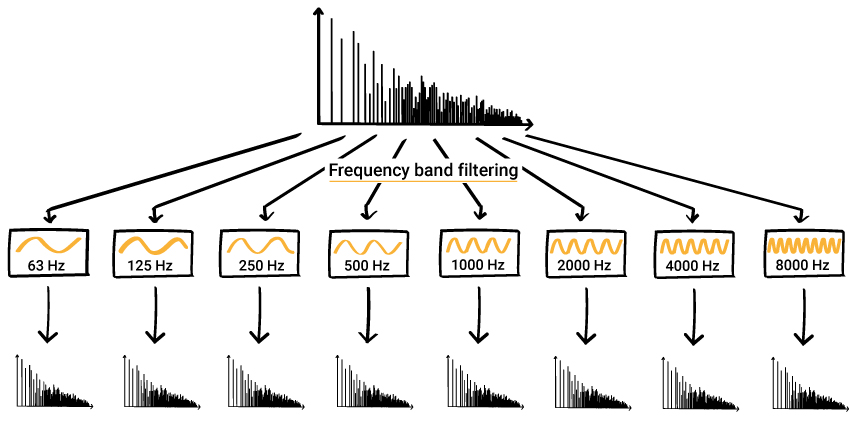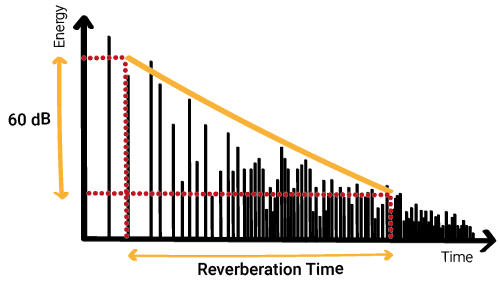
Do you work on building projects and would like to know more about sound reverberation so that you can better understand part of the acoustic design? Then this series of posts is for you.
Part 1 (here) takes you through the very basics of sound reverberation including:
- What sound reverberation is.
- How sound reverberation is measured.
- What the reverberation time is.
Part 2 will shed light on some specialist indices used for the design of spaces for spoken and/or musical performances.
And finally, Part 3 will explain some of the basic principles of reverberation control.
Enjoy the read!
(See at the end the references used to confirm the concepts)

Do you want to be notified when new posts are published?
Why don’t you subscribe to Atelier Crescendo’s newsletter by clicking here?
What is sound reverberation?
Reverberation happens in a space when the sound of a source is reflected into multiple reflections. They build up and decay as they are absorbed by the surfaces and the furnishing.
The reverberation characteristics of a room make its acoustic footprint. A little bit like an instrument responding to an excitation with its own timbre.
Acousticians study sound reverberation because it directly influences:
- the intelligibility of speech
- the clarity and warmth of music
- (when it is particularly high) the background noise

Sound reflections are often represented as rays traveling in different directions and arriving at different times. Each ray transports acoustic energy and loses some amount as it travels through the air or hits an obstacle.
The sound reverberation in a space depends on a few different aspects including:
- the acoustic properties of the surfaces and finishes
- the location of the surfaces
- the location of the source and the receiver
- the volume of the space
The ideal reverberation conditions for a room depend on its use. Some spaces (like classrooms or recording studios) need rather “dead” reverberation characteristics. Others need a medium reverberation (like assembly halls, theatres for drama, concert spaces for amplified music, etc), whilst others work best when they are very reverberant (large symphony halls for acoustic music, spaces for choral music, etc).
How do we measure sound reverberation?
You can generally study sound reverberation by analysing how the sound energy evolves in a room after a short sound burst or after a source is interrupted (there are other measurement methods but they won’t be discussed here). Its basically observing how a room behaves under a sound excitation.
You can analyse the reverberated sound energy in different ways:
- in sound pressure level.
- in duration: how long it takes for some or all the sound to partially or entirely disappear.
- in arrival time: when does the reflected sound arrive to a receiving location. You can split the reverberation into three different parts:
- the direct sound
- the early reflections
- the late reflections
From the representation of sound as rays, you can come up with the diagram to the right commonly called a reflectogram:

- in frequency: what is the frequency content of the reflected sound. To do this, the sound energy is filtered for different frequency bands that generally range from 63 Hz to 8000 Hz.

Note
Most buildings are acoustically designed for people to be able to hear, communicate, concentrate or even rest comfortably. So because the human ear is more sensitive at mid-frequencies and the human voice emits sound around the mid-frequencies, the acoustic designer generally concentrates on the reverberation conditions at 500 Hz, 1000 Hz and 2000 Hz.
Sometimes, it is also important to control the reverberation conditions at low frequencies. This is discussed a little bit more below.
- in space: where the reflected sound arrives from to a listener, i.e. to the top, to the back, to the bottom or to the sides of the listener’s head.

Depending on the use of a space and the acoustic characteristics you want to concentrate on, you can either isolate or combine the above aspects.
For example, you can:
- measure how fast the reverberated sound disappears; you will have an idea of how echoey a room might be.
- compare the sound energy arriving within the first 50ms against the total energy; you will have an indication of how intelligible a spoken message could be.
- compare (during the first 80ms) the energy arriving to the sides of a listener against the energy arriving in any direction; you will have an indication of how surrounded by sound a listener might feel and how broad a source might be perceived (this is particularly useful to know for spaces where acoustic music is played).
- compare the energy of a source with the rest of the reverberated sound against the energy of just the source; you will have an idea on amplification power of a room.
Note
the above examples come from very standardised processes, and for ease of understanding, they have been simplified. More details are given in Part 2 of the series.
All the above aspects are quantified with particular acoustic indices that are psychoacoustic based.
The section below concentrates on the reverberation time index, which is the starting point of any sound reverberation design.
Part 2 (published soon) will present some specialist indices that are very useful for the design of spaces for spoken or musical performances.
Reverberation time (RT or T)
The reverberation time (RT) is the one index that acousticians use to rate or design reverberation characteristics. Practically, it tells you how long it takes for sound to disappear in a room.
Reverberant spaces, like churches, have higher reverberation times than acoustically “dead” spaces, like recording studios.
In more technical terms, you analyse the impulse response and measure how long (in seconds) it takes for the acoustic energy to decay by 60 dB.

As explained above, the impulse response is filtered for different frequency bands (between 63 Hz to 8000 Hz) and the RT is measured from each energy decay. The RT is measured in different frequencies generally ranging from 63 Hz to 8000 Hz.

Note
as mentioned above, the acoustic designer generally concentrates on the reverberation conditions at 500 Hz, 1000 Hz and 2000 Hz, the mid frequencies. Therefore, the RT targets are generally an average of some or all the values of 500 Hz, 1000 Hz and 2000 Hz frequency bands.
Hence Tmf (used for example in education spaces) which is the average of the reverberation time values at mid frequencies.
Sometines, it will be important to consider the reverberation time at frequencies lower than 500 Hz.
This is the case for medium to large spaces where acoustic music is played. Compared to the mid and high frequencies (500 Hz, 1000 Hz, 2000 Hz, 4000 Hz and 8000 Hz), a controlled increase of the reverberation time at low frequencies (63 Hz, 125 Hz and 250 Hz) create warmer listening conditions.
For Special Education Needs (SEN) classrooms, specific design requirements are in place in a wide range of frequencies, including at the frequency bands 125 Hz and 250 Hz. This is because too much low frequency reverberation can mask the sound of the teacher’s voice and make it harder to clearly hear what (s)he says (see Acoustic Design of SEN (Special Educationnal Needs) classrooms for more information on the acoustic design of such rooms).
Acoustic references
See below the references used to confirm the above concepts:
-
Auditorium Acoustics and Architectural Design – Mike Barron;
-
Concert halls and Opera Houses – Music, Acoustics and Architecture – Leo Beranek
-
ISO 3382-1: 2009 – Acoustics — Measurement of room acoustic parameters — Part 1: Performance spaces
